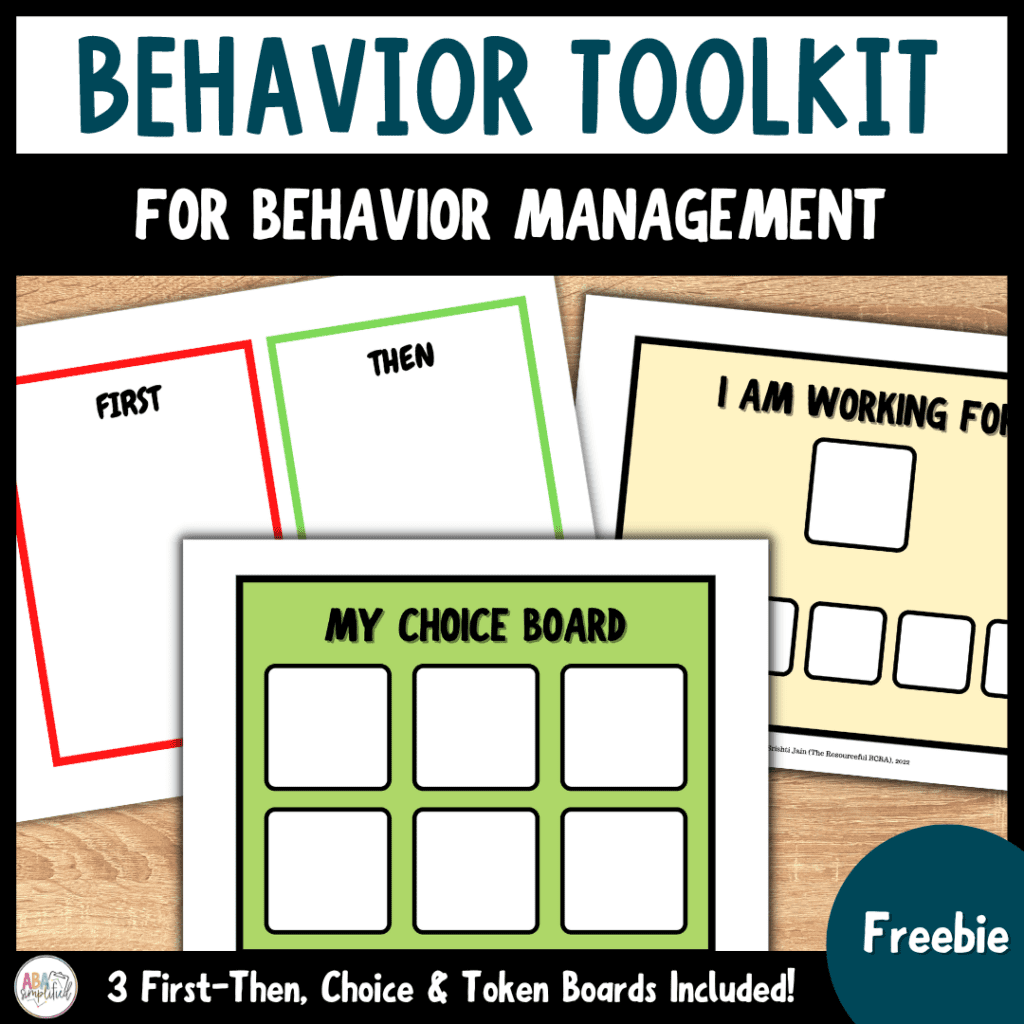BLOG POST
Understanding Antecedent Interventions
Published on 9th December 2023 by ABA Simplified


In today’s blog post, we’re going to shed some light on the importance of antecedent interventions. Antecedent interventions simply involve making changes to the environment to help bring about behavior change in our learners. I like to think of them as a safety net. They might not catch (or reduce the likelihood of) every single challenging behavior but they will catch (or help reduce) most of them! I love antecedent interventions because they help us act proactively rather than reactively. It puts our learners in a space to be able to learn skills (AKA learn replacement behaviors) that will help bring about more permanent behavior change!
What Are Antecedent Interventions?
Based on the hypothesized or known function of behavior, we can develop antecedent interventions that can help modify the environment in a way that reduces the likelihood of the target behavior. Keep in mind that they will not eliminate the target behavior completely. It’ll just reduce the chances of their occurrence. These are proactive strategies i.e. they are applied before a behavior occurs. This is in contrast to reactive strategies that are applied after a behavior occurs. As an example, prompting use of a communication method is a reactive strategy (assuming this prompt occurs after the behavior has taken place). Instead, making sure a communication method is available to use and the learner is being taught how to use it outside of when a behavior occurs is an antecedent strategy.


Antecedents and Setting Events That Can Affect Behavior
- Change in routine
- Demand placed
- Asked to wait (delayed access)
- Denied access
- Negative interactions with peers, parents or other people
- Medication changes
- Missed meals
- Presence of certain people or number of people in the area
- Noise level
- Sensory stimulation (visual, tactile, auditory etc)
- Family/Home Variables (e.g. visiting family members, divorce, birth of a sibling, moving homes etc.)
- Current health status of the child
Benefits Of Antecedent Interventions
The benefits of antecedent strategies go beyond the immediate prevention of challenging behaviors. They encourage a proactive, individualized, and skill-focused approach to behavior change, ultimately creating environments that support positive outcomes for our learners. So, lets take a closer look at the potential benefits of using antecedent interventions.
- Prevention Of Challenging Behaviors: By identifying and modifying potential triggers or antecedents that lead to undesirable behaviors, practitioners can create environments that are less likely to evoke problem behaviors in the first place.
- Encourage A Proactive Approach to Behavior Change: Antecedent strategies emphasize a proactive rather than reactive approach to behavior change. Instead of waiting for challenging behaviors to happen and then addressing them, these strategies focus on modifying the environment beforehand to set our learners up for success.
- Supports The Individual Needs of Your Learners: Antecedent interventions allow for a tailored approach to behavior support. By understanding the specific antecedents that trigger challenging behaviors, we can customize interventions to meet the unique needs of our learners, leading to more effective behavior intervention.
- Increased Learning Opportunities: Antecedent strategies not only aim to prevent challenging behaviors but also create an environment conducive to learning and skill development. For instance, if a learner has difficulty with academic tasks, we can encourage communication by teaching them to request for help or a break.
Function-Based Approach to Antecedent Interventions
When attempting to reduce specific behaviors, we first need to understand the “why” behind the behavior. Applying interventions without a known function, means that we’d essentially be shooting in the dark. Instead, we can apply targeted, function-based antecedent interventions so we’re sure that we are getting to the root cause of the behavior.
Escape
Addressing behaviors maintained by avoidance or escape involves implementing targeted antecedent strategies. These are some function-based antecedent interventions that can help:
- Reduce Task Complexity: Ensure instructions are suitable for their skill level, considering factors such as language comprehension. Breaking down instructions or simplifying them, such as using concise phrases like “Get shoes” or “Clean up,” can enhance understanding and reduce the likelihood of escape-maintained behaviors.
- Incorporate Interests: Including the learner’s special interests in instructional materials can be a powerful motivator. By aligning activities with their special interests, we can increase engagement and reduce the likelihood of escape behaviors.
- Use Visual Supports: Visual supports play a crucial role in reducing escape-maintained behaviors. Set clear expectations using visual supports, such as visual timers, first-then boards, and visual schedules. These visuals provide a tangible representation of the task duration and sequence, offering predictability and structure, which can be reduce escape-maintained behaviors.
- Offer Choices: Offer options within tasks or activities, allowing the learner to have a degree of control. Make sure to offer choices between options that are acceptable to you. Some examples include choosing where to sit, choosing the order of activities etc.
Functional Communication Training: Teaching our learners to ask for help or request a break is a vital component of managing escape-maintained behaviors. Functional Communication Training (FCT) focuses on equipping them with alternative, more effective ways to communicate their needs, reducing the reliance on escape-maintained behaviors as a form of communication.


Attention
Addressing behaviors maintained by access to attention involves implementing targeted antecedent strategies. Remember that there is no such thing as “good” attention and “bad” attention. This means that verbal corrections, redirection, reprimands can still reinforce behavior, despite it not being our intent. These are some function-based antecedent interventions that can help:
- Non-Contingent Reinforcement: This involves providing positive attention on a time-based schedule throughout the day, irrespective of the occurrence of the target behavior. By doing so, you proactively meet the learners’ need for attention, reducing the likelihood of attention-maintained behaviors.
- Set Clear Expectations: Communicate explicitly when attention will be given and under what circumstances. Setting consistent rules and boundaries creates a structured environment, making it easier for our learners to understand when positive attention is available.
- Use Visual Supports: Visual supports can significantly aid in reducing attention-maintained behaviors. Employ visual schedules, first-then boards etc to indicate when attention will be given. Visual aids serve as tangible reminders, offering our learners a clear and predictable understanding of when they can expect positive attention.
- Teach Waiting: Practice waiting for increasingly longer durations, gradually extending the time between requests for attention and the provision of attention. TIP: Try to make this more natural by being busy. You could be filling in data sheets, reorganizing materials or anything else! Let them know you need a few seconds or a few minutes and then you’ll be with them!
- Functional Communication Training: Maladaptive attention-maintained behaviors often stem from a lack of effective communication skills. Functional Communication Training (FCT) addresses this by teaching our learners more appropriate ways to seek attention. This could involve using gestures, signs, words, or other communication methods to express their needs, reducing the reliance on maladaptive behaviors.


Access to Tangibles
Addressing behaviors maintained by access to tangibles involves implementing targeted antecedent strategies. These are some function-based antecedent interventions that can help:
- Non-Contingent Reinforcement: Provide access to desired items on a time-based schedule, irrespective of the occurrence of the target behavior. By proactively offering access to preferred items, you can reduce the motivation for engaging in maladaptive behaviors to obtain those items.
- Priming: Priming is involves providing warnings ahead of time about the ending of a preferred activity. This allows our learners to prepare for the transition, reducing the likelihood of challenging behaviors arising from abrupt transitions.
- Use Visual Supports: Visual supports, such as visual timers, first-then boards, or visual schedules play a crucial role in managing behaviors maintained by access to tangibles. Visual timers help our learners to see how long they have left before access to the item or activity will end or how long they need to wait before they can gain access.
- Teach Denial and Waiting Skills: Teaching our learners to accept “no” and to wait for access to preferred items is a very valuable skill. By incorporating denial and waiting skills into their repertoire, individuals become better equipped to handle situations where immediate access is not possible. This reduces the likelihood of engaging in maladaptive behaviors as a means to gain access.
- Functional Communication Training: Functional Communication Training (FCT) focuses on teaching our learners a more appropriate way to communicate their desire for access to items. They can use gestures, signs, pictures, AAC devices or words to communicate their needs and wants!


Automatic or Sensory
Addressing behaviors maintained by automatic reinforcement, where the behavior is reinforcing in and of itself requires further understanding of the specific sensory needs of your learner. Matching the replacement behavior to their specific sensory needs will allow for more successful intervention outcomes. These are some function-based antecedent interventions that can help:
- Non-Contingent Reinforcement: Providing time and space for sensory activities on a time-based schedule can be a great way to address behaviors associated with automatic reinforcement. By offering activities that align with the child’s specific sensory needs, we can satiate (i.e. abolishing operation) our learners’ need to engage in maladaptive behavior to satisfy their need. For example, if a child engages in dumping behaviors, providing structured dumping-related activities can be a proactive approach.
- Incorporate In Skill-Acquisition Programs: Where possible, incorporate sensory activities into skill-acquisition programs. You can work on manding, tacting, listener responding, imitation programs and much more! This approach not only integrates the sensory needs of our learners, but also can help expand on the activities they might want to do within their sensory play.
- Movement Breaks: These breaks provide an outlet for learners that engage in behaviors like running, climbing furniture etc. This is best suited for children who always seem to be “on the go”. Incorporating movement into the daily routine and skill-acquisition programs can be a proactive measure to reduce the occurrence of maladaptive behaviors. As an example, if we are working on tasks like puzzles, color sorting, identical matching etc, they can be embedded within an obstacle course where the child goes through a tunnel, completes a matching activity, walks on a balance beam, completes a puzzle, jumps on a trampoline etc.
- Ensure That Physiological Needs Are Met: It’s essential to attend to the child’s physiological needs. Our learners must be well-rested, adequately fed, not feeling sick, and generally in a comfortable physical state, which can help reduce the likelihood of engaging in maladaptive behaviors.
- Seek Medical Advice: In some cases, our learners might be engaging in “maladaptive behavior” due to underlying medical issues. Seeking medical advice and consultation with healthcare professionals can provide valuable insights into potential medical causes or conditions influencing the behavior. A great example of this could be head-banging behavior that is a result of persistent migraines.
Overall, the benefits of antecedent interventions extend beyond the immediate prevention of maladaptive behaviors. They foster a proactive, individualized, and skill-focused approach, creating environments that support positive outcomes for learners. By preventing maladaptive behaviors, encouraging a proactive approach, and supporting individual needs, antecedent interventions pave the way for increased learning opportunities and effective behavior intervention.
Make sure to get my FREE Behavior Toolkit that comes with a variety of first-then boards, token boards, and choice boards! Click the image to check it out.


Sign Up For Blog Updates!
Subscribe to stay in the loop with my latest blogs!
Thank you!
You have successfully joined our subscriber list.

